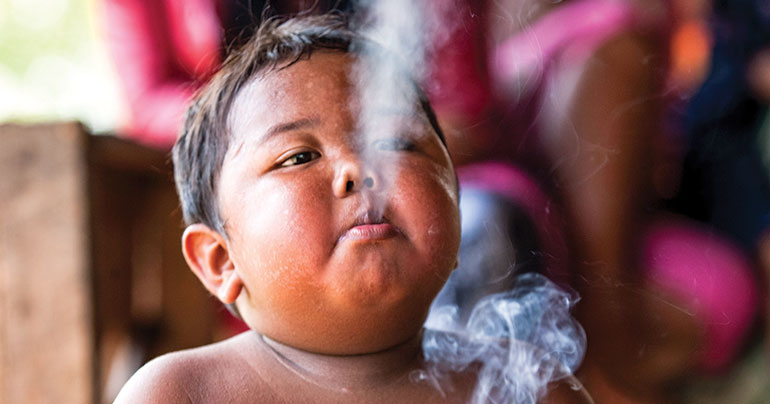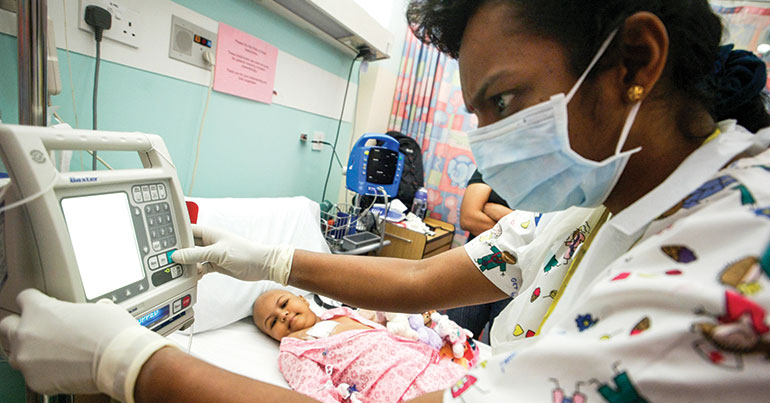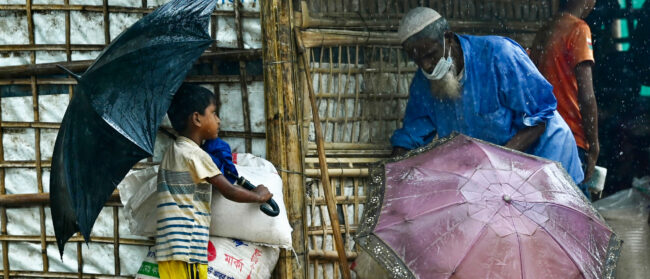In a stark white office on the second floor of the newly inaugurated National Cancer Centre (NCC) in Phnom Penh’s Calmette Hospital, Eav Sokha, director of the centre, sits jovially sketching a rough map of the Kingdom on a scrap of paper. “In the future, we expect to establish a national cancer network triangle,” he says with a smile, pointing at the NCC and two future centres planned in Siem Reap and the northeastern region of the country. “That is our dream. With these three cancer centres established, the goal is to cover 70% of our total cancer patient population.”
The groundbreaking NCC, a $36m project that opened at the beginning of this year, is one of only two facilities where cancer patients in the Kingdom can receive treatment. The other, Phnom Penh’s Khmer-Soviet Friendship Hospital, could treat only about 500 out of 15,000 cases per year. The NCC can currently treat 1,000 new cases per year, with a goal of 2,000.
More than 14 million people worldwide were diagnosed with cancer in 2012, a figure that is expected to come close to 25 million over the next two decades, with the burden falling overwhelmingly on low- and middle-income countries, according to the 2014 World Cancer Report from the International Agency for Research on Cancer, which forms part of the World Health Organisation (WHO). It is estimated that about 60% of global cancer incidence occurs in developing countries, and rates across Southeast Asia are expected to surge in the coming years, reaching levels 40% higher by 2030 than those in 2012.
Faced with ill-equipped infrastructure and limited resources, as well as nascent healthcare systems, Asean nations must act fast to combat a rising health crisis. A 2015 report by the George Institute for Global Health examined the economic impact of cancer in eight Asean countries: of the 10,000 first-time cancer patients monitored over the course of a year, more than 75% of them either died or faced economic catastrophe within that same year, their suffering compounded by low socioeconomic status, lack of insurance and late-stage diagnosis.

One cause of the upsurge in cancer cases comes as a natural result of economic development, particularly increasing life expectancies and changing lifestyle habits coupled with poor hygiene, says WHO. Yet experts recommend taking the apparent incidence increase with a pinch of salt – the lack of national cancer registries across many Southeast Asian countries, plus improvements in diagnostic capabilities, means that in the past many patients went undiagnosed, and accurate numbers are still lacking today.
“The medical technology here [is] now much better,” says Sokha. “Now [that] we detect more cancer, the incidence [has] increased. Before, I think that the incidence [was] also high. But we don’t know.” Southeast Asia has the least number of countries with national cancer registries, at 60%, according to the 2014 World Cancer Report, making it difficult to plan and implement effective treatment strategies.
The greatest challenge to cancer care, and another consequence of development, is misplaced government priorities, according to Clarito Cairo Jr, programme manager of cancer prevention and control for the Philippines Department of Health. Cairo takes issue with the $67m invested in the controversial anti-dengue vaccine Dengvaxia. “The WHO’s Millennium Development Goals did not include non-communicable diseases like cancer,” he says. “That’s why the lower middle-income countries like the Philippines did not prioritise cancer. Only with the Sustainable Development Goals [in 2016 did] our government [start] to prioritise cancer.”
Talking about insurance is something new for Cambodia. Now, we look like a baby
Eav Sokha
On a policy level, the burgeoning national insurance schemes across the region are slowly shouldering the weight of out-of-pocket expenses. In 2014, Indonesia launched national health insurance that it hopes will cover all citizens by 2019. The plan has already led to a reduction in the number of patients treated out of pocket from 50% to 10%, says Soehartati Gondhowiardjo, president of the Indonesian Radiation Oncology Society and chair of Indonesia’s National Cancer Control Committee.
For some nations, innovative funding methods have paved the way to increased health coverage. In the Philippines, the introduction of a ‘sin tax’ – collected through levies on products such as tobacco – has boosted a cash-strapped health budget. “In 2010 we had around 10 billion pesos [$19.2m], and then this year we have 180 billion pesos [$3.5 billion],” Cairo says. “The budget at the Department of Health has greatly increased. So the access to services for health has also enhanced. The Filipinos will now go to hospitals without out-of-pocket expenses.”
In Cambodia, government investment in a social security fund shows its commitment to prioritising healthcare, according to Sokha, though the system is still in its infancy. “I think that talking about insurance is something new for Cambodia. Now, we look like a baby,” he says with a laugh. Sokha says the government remains unsure how much treatment the insurance should cover. With tight budgets, he says, they should tread carefully, as relieving the burden of out-of-pocket expenses may impact the quality of care patients receive.
Sokha credits the International Atomic Energy Agency (IAEA) – an organisation that promotes the safe and non-military use of nuclear technology – for much of the new centre’s success. The agency has invested about $1.5m in the project, donated more than $700,000 worth of equipment and trained half of the NCC doctors under the IAEA fellowship programme, on top of continued technical support. It even managed to convince the Cambodian government that the project was worth pursuing amid hesitations and scepticism over the safety of nuclear technology.

For Indonesia’s Soehartati, the solution lies in private-sector partnerships. With the increasing number of patients, partly a product of improved coverage as more patients can now afford to come to the hospital, turning to the private sector seems like a smart option as government budgets are increasingly under pressure to supply adequate equipment and drugs. “In my profession right now, around 15 to 20% of [radiotherapy] equipment in the country belongs to the private sector,” she says. “Some [private firms] set up their own private hospitals. But some of them, they put their equipment in the government hospitals… It works very well.” Having granted a concession to private companies for the operation of the machinery, the government will eventually own the equipment once the company has recouped its investment, she says. The National Cancer Control Committee is also encouraging private firms to set up in areas that lack adequate facilities – such as Papua province, the Maluku islands and the west of Borneo’s Kalimantan – so advanced healthcare will become much more accessible to Indonesia’s massive and sprawling population.
Other such public-private partnerships are sprouting around the region, with countries increasingly looking abroad for help in procuring up-to-date technology and drugs. Takeda Pharmaceuticals, a Japan-based international firm and the largest pharmaceutical company in Asia, partly funds cancer drugs in Singapore, Malaysia and Taiwan for patients who could not otherwise afford them.
Sokha’s excitement is palpable as he lists the state-of-the-art facilities at his new centre; nevertheless, he admits that in Cambodia, cancer treatment is playing catch-up: “When we look to our neighbours, we are still far behind. Now we [have] started to move up with economic growth… [and are] trying to chase our neighbours in Southeast Asia. We want to open accessibility to our people, but with very good quality of care.”
Despite improvements in systems and facilities across the region, it seems clear to those on the frontline that challenges lie ahead. “It is not something like moving our hand,” says Soehartati. “It takes time because we have to change behaviour – the behaviour of the people as well as medical doctors and the decision-makers in the country.”


